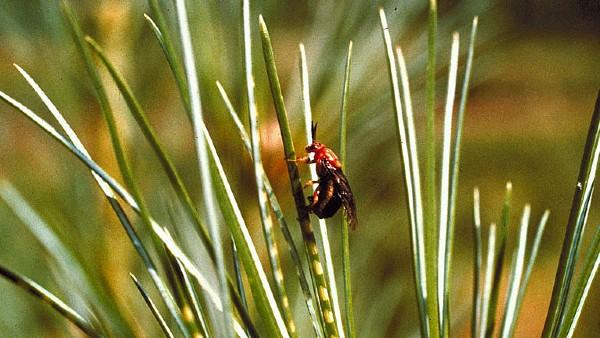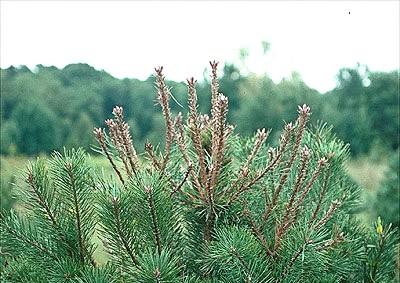Key points
- Larvae resembling caterpillars feed in groups and eat the needles from terminal branches.
- Large infestations may defoliate and kill small pines.
- The adult sawflies are 1/2 inch, brownish; stout bodied and resemble bees.

- The female deposits her eggs in needles, which results in rows of tan spots.
- The egg spots and larvae are present from May -June and again from August - October.
- The newly hatched larvae feed in groups and are usually found defoliating terminal branches.
- The mature larvae are 1 inch long, have reddish heads, and a yellowish-white body with 6 rows of irregular black spots.
- Fully developed larvae spin tough, golden brown cocoons in which to pupate.
- After pupating the adult sawfly emerges from the cocoon.
- There are two generations per year and prepupae overwinter in the soil.
- This sawfly prefers to feed on jack, red, shortleaf, loblolly, slash, longleaf, pitch, Swiss mountain, and mugo pines. It may occasionally attack white pine and other conifers.
- Stressed trees are most often attacked.
Management
- Hand pick and destroy isolated infestations.
- Heavy infestations on many trees or large trees may be sprayed with a summer oil when larvae are small or a contact insecticide when larvae are large.
- Even though sawfly larvae resemble caterpillars, they are not. Bt will not kill them.
Other pine sawflies
- There are approximately 10 other species of sawflies that attack pines in Maryland, including European pine sawfly (which pupates either in the soil or sheltered areas in the tree), Blackheaded pine sawfly and White pine sawfly.
- Their appearance will vary somewhat, but their behavior and control is the same as the Redheaded pine sawfly.

